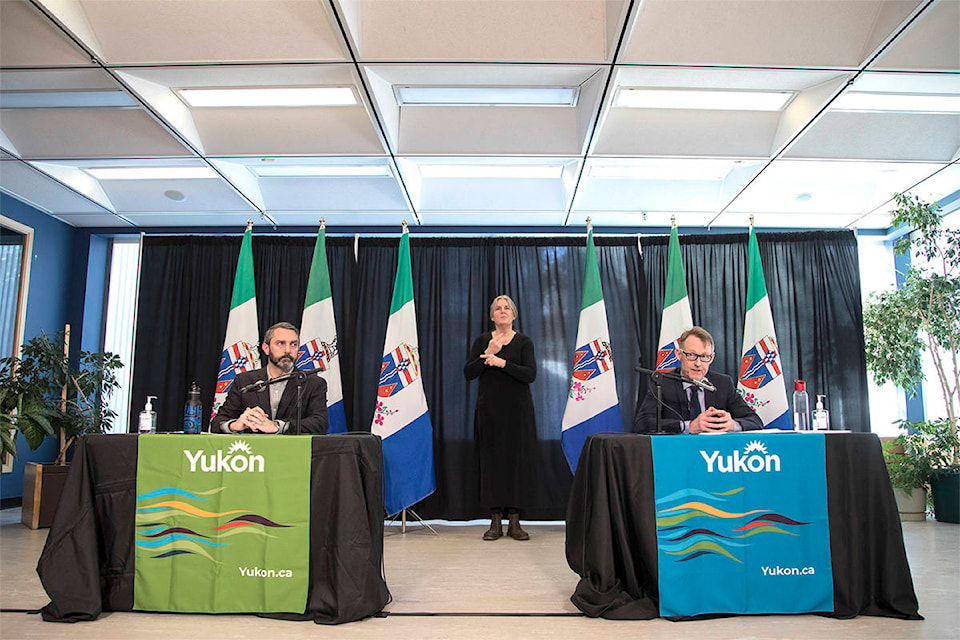As COVID-19 case numbers rise dramatically in Nunavut and British Columbia, Yukon officials are urging caution and considering a new mask policy while preparing for the eventual roll-out of a vaccine.
Premier Sandy Silver said Yukoners need to remember the threat of the pandemic, particularly in light of three new cases of COVID-19 diagnosed in the territory this past week.
“The new case, combined with the dramatic increase in cases in Nunavut in the past week is a stark reminder that we are still in the grips of this pandemic,” Silver said. “Canada’s second wave of COVID-19 is reaching the territories and we need to make sure that we’re doing everything we can to protect our communities.”
The two new COVID-19 cases confirmed on Nov. 12 and Nov. 17 are connected to travel outside of the B.C. and Northwest Territory bubble, according to Chief Medical Officer of Health Dr. Brendan Hanley
He said the first individual “did everything right” in terms of isolating and getting tested, but the potential exposures in A&W and Save On Foods occurred prior to the onset of symptoms.
A second case was confirmed Nov. 17 and was linked to case number 24. A public exposure notice was issued for Lister’s Motor Sports in addition to previously published information on A&W and Save-On-Foods.
“Contact tracing is still being carried out with some testing of contacts and it is possible we’ll see further cases associated with this case,” said Hanley at the COVID-19 update, prior to case number 25.
Hanley said the individual being identified as case number 24, “is doing well.”
A third person, a non-Yukon resident, was also diagnosed inside the territory and is currently recovering in isolation. Because the person is a visitor, rather than a resident, that case will not count towards the territory’s totals.
“Contact tracing again has been carried out with some testing of higher risk contacts and there are no identified cases linked to this one,” Hanley said.
Case counts continue to rise across the country, with large increases in both B.C. and Nunavut.
“Whether cases are Yukoners or outsiders, we remain fortunate that all our cases to-date are linked to travel and we continue to have no evidence of community spread,” he said. “From our viewpoint, it almost seems like we’re in the eye of some huge global COVID cyclone. I certainly understand the stress and anxiety this is causing for us.”
Hanley cautioned Yukoners to follow public health advice coming out of B.C. as the province moves into heavier restrictions. He said only essential travel should take place, and that those who travel within the bubble should “maintain a low profile” and watch for symptoms when they return.
Hanley said no cases within the territory have been related to travel in B.C. since the bubble was established on July 1.
Silver added that there is an option to require self-isolation for certain areas of B.C. rather than the entire province. He used the lower mainland as an example, where cases are surging in comparison to Vancouver Island or the interior.
“When it comes to regions that we’ve already opened up like B.C., for example, we could have certain sections of provinces revert, if we felt that there was a problem,” he said. “So we are monitoring the current situation.”
Hanley also referenced the rising case counts in Nunavut and said the two jurisdictions are sharing detailed information. He noted that the territory has a strict border closure in place, but has still seen cases spread.
“I think one of the lessons is that if we focus solely on borders and self-quarantine measures and entry, and don’t pay attention to the rest, we can quickly see problems arise,” he said.
“The critical thing is what we do to prevent transmission. How we prevent cases from becoming outbreaks, how we prevent outbreaks from becoming large outbreaks, or multiple outbreaks, or turning into community transmission,” he said.
Hanley said a territory-wide mask policy is being carefully considered, but no changes are taking place yet. He suggested Yukoners wear masks when unable to physically distance and recommended buying reusable non-medical masks for those who don’t yet have them.
“I am in conversation with the government about potential masking policies for the territory for enclosed public spaces. I know and see that more and more people are using masks in public settings. I know there is public readiness for direction in this regard,” he said.
“Rather than me advising the government to do this overnight, there are many considerations to address,” Hanley said.
Silver said the federal government and provinces and territories are working closely together on preparations for a COVID-19 vaccine.
“Like people all around the globe, we are anxiously anticipating an approval of a vaccine,” Silver said. “Plans for the territory are already underway. This includes identifying storage space, the number of required doses, staff requirements and plans for distribution.”
Silver said the seasonal flu vaccine — unrelated to a COVID-19 vaccine — have seen an uptick this year. So far 10,830 Yukoners have received their flu shot, compared to a Yukon-wide total of 11,864 people last year.
Finally, residents in long-term care homes will now be able to designate two additional family or friends to be added to their visitor list.
Two new Civil Emergency Measures Act charges were laid on Nov. 12 and Nov. 15 for failures to self-isolate.
Contact Haley Ritchie at haley.ritchie@yukon-news.com
